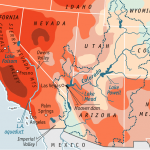Taxing food security, the drying of the West is subject to change food production sooner than later. When we evaluate the numbers, why do we continue to put all our eggs (and all perishables) in one basket?
Agriculture accounts for 80% of water consumption in California, for example, but only 2% of economic activity. Farmers flood the land to grow rice, alfalfa and other thirsty crops. By one account, over the years they have paid just 15% of the capital costs of the federal system that delivers much of their irrigation water. If water were priced properly, it is a safe bet that they would waste far less of it.










